
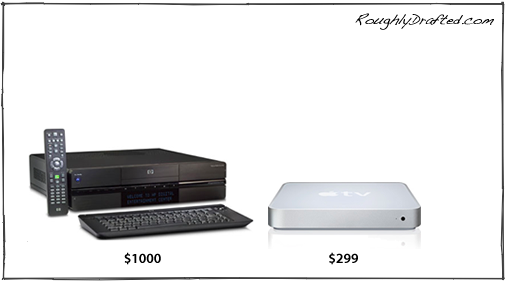
Windows XP Media Center Edition vs Apple TV
Apple critics tried hard to pretend that this year’s Macworld was a huge disappointment because no new Macs or iPods were trotted out on stage. Of course, these same critics have also long lambasted Apple for not offering a "true video” iPod, nor a handheld mobile, nor a Media Center Mac, nor other copies of Microsoft strategies.
What they failed to catch at Macworld was that Apple has leapfrogged Microsoft's consumer electronics efforts with just three simple product introductions:
-
•the new AirPort Extreme offers an obliterating alternative to Windows Home Server at a fraction of the cost
-
•the new Apple TV slingshots a rock right into the forehead of Microsoft’s Media Center PC
Apple recently commented that it would not be immediately releasing any more new product categories, so it’s time to sit back and watch the fireworks. 

Yesterday's Windows Home Server vs AirPort Extreme pitted Microsoft's announced plans for a home server--due in the second half of year--against Apple's currently shipping AirPort Extreme.
In contrast to Microsoft’s home server plans first officially unveiled in January, Microsoft’s Media Center PC was first introduced back in 2002, and its origins date back even further.
Introducing Windows XP Media Center Edition
At CES 2002, the project was known under the code name Freestyle; it was later delivered as Windows XP Media Center Edition. Like the new Windows Home Server, it is only available bundled with a new PC from select OEMs.
While sold as an "edition" of Windows, it is essentially just a standard Windows XP that includes Media Center, an application designed specifically for use on TV screens, using large fonts and simpler navigation that can be controlled via a remote control rather than a mouse and keyboard. The Media Center app handles:
-
•presentation of user photos, music, and video stored locally on the Media Center PC or on a network drive
-
•viewing TV from antenna, cable, or satellite, using one or more hardware TV tuners
-
•acting as a Tivo-like DVR to record TV to a hard drive, burn to DVD, or copy to a portable player
-
•streaming TV or recorded video to an Xbox 360 or other Media Center Extender to watch on a different TV
A Swing and a Miss
Despite valiant efforts to improve upon the product with annual updates, Windows Media Center PCs aren't flying off the shelves. It's easy to guess why: they offer little more than other DVRs, but cost a lot more.
The basic problem is that when Microsoft visualizes a solution to a problem, it's always a PC running Windows.
That's often a bad assumption, because PCs running Windows are not all that great at being general purpose computers. Pitting them against custom designed solutions is like throwing a stray mutt in a cage match against a Presa Canario and a pit bull: hello, gruesome third place!
What is really interesting about Microsoft’s Media Center lead balloon is not its failure over the last five years, but rather the five years of development that proceeded it: a product called WebTV.
The Fall of WebTV: Nothing Learned
One might think Microsoft would have learned something after buying up WebTV Networks in 1997 and destroying the company and its product. One would be wrong.
The WebTV startup was founded just two years earlier in 1995, and was made up largely of employees from Apple and its General Magic spin off. The concept was to deliver a sophisticated set top box with Internet web browsing in the form of a low cost Network Computer that could download software directly from WebTV servers.

The device itself was originally a diskless box with 2 MB of RAM, a 64-bit RISC processor, a TV tuner, a modem to download programming schedules, video support for adapting computer graphics for display on a standard TV, and simplified navigation to allow users to browse the web without needing a mouse.
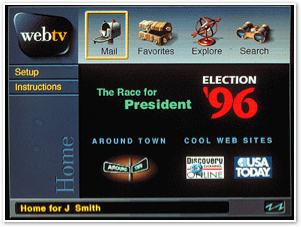
Just months after assuring WebTV employees the company would never to sell out to Microsoft, founder Steve Perlman announced to employees that he had, along with investors, sold out to Microsoft.
Many of its 250 employees protested, and Microsoft-hater Sun challenged the deal but it went though anyway; Microsoft took over the project with the proviso that at least 80% of the company's engineers stay on board.
Under Microsoft, WebTV continued as a subsidized box sold under a subscription plan. Signing up long term users ended up being nearly impossible, and the churn of short term subscribers meant the company was losing money handing out free hardware and never recouping enough subscription fees to keep it going.
In its typical crisis management style, Microsoft first rebranded WebTV as MSN TV--change the name, forget the failure!--then converted the box into a Celeron-based PC running WinCE, called MSN TV2--if nothing else works, start from the beginning: a PC running Windows!
That left Microsoft still selling an expensive box at a loss, dependent upon subscription revenues. Even worse, now that it was just another PC, crackers found out how to install free software on the box, turning the MSN TV2 into a Microsoft hardware subsidy for Linux users. Doh!
In parallel with converting the WebTV into a money pit PC as a set top box, Microsoft put its WebTV engineers to work on the Xbox, and created another stripped down PC to sell at a loss. Doh!
As both projects burned up billions of dollars, the company decided to instead apply the same technology to work on a full size PC, and salvage WebTV as a component of Windows.
Hey PC Lackeys, Make Us Rich
Rather than going out of business selling subsidized PCs with expensive HDTV tuners and fast enough hardware to process and record video, Microsoft announced Freestyle as a specialized version of Windows that OEMs could bundle on their own hardware and sell themselves.
This attempted to shift all the risk to PC makers, a strategy that had worked for Windows in the 90s, when PC makers fought each other to the death. Regardless of the outcome, both the victors and the vanquished paid Microsoft for Windows software licenses.
By converting MSN TV into Windows Media Center, Microsoft realized that the PC making stooges could lose all the money competing over sales of new TV-centric PCs, allowing Microsoft to safely return to its easy profiteering as a software slumlord.
Competition Gets in the Way
Without any competition, Windows Media Center might have had a chance. However, cable and satellite companies didn't see any need to sell their subscribers on Windows Media Center PCs when they could more profitably sell DVR boxes of their own.
Home users have to go out of their way to buy the relatively expensive Windows Media Center PC.
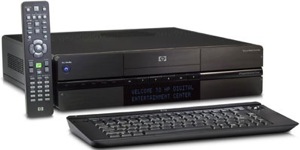

However, it results in a product pitted against direct competition: embedded set top boxes like the Tivo and cable companies' own house branded gear, as well as open source projects such as Myth TV, which allow skilled users to build their own DVR-based PC from parts.
Microsoft hates competition, and for good reason. It's a poor competitor.
¿Por qué no?
Why buy a whole new PC just to play video, photos, and music from a computer on a living room TV? Why not just buy a simple media extender relay device?
As long as you're buying a media extender, why not throw in wireless? And why not Wireless N, the new high speed standard for 802.11 WiFi networks? And why not throw in a hard drive, so users can spool their content to the TV and watch it without any streaming interruptions?
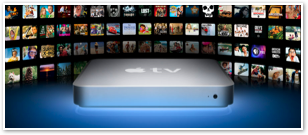
Introducing Apple TV
Apple TV fits the same needs as a Windows Media Center PC, but at a much lower price point: under $300 rather than around $1000.
In addition to getting video, photos, and music from a PC library, it's also integrated with iTunes, so users can download what they want to watch rather than fishing from a stream of paid subscription content.
With cable plans commonly $50-100 per month, Apple TV offers an alternative of downloading movies and TV programs à la carte for less, with no monthly commitment and no charge when nothing is watched.
Compared to cable and satellite subscription packages, Apple TV lets users buy the few shows they actually watch, and throw in movies they chose to buy, rent overnight, or get from services like Netflix .
.
Given the choice, users commonly prefer to pay for what they want, not pay a rental fee for the potential of an all you can eat service:
-
•Netflix
offers a variety of plans where users can pay for only as many movies as they watch in a month
-
•Rental stores charge per rental, not per monthly membership
-
•Most people avoid subscribing to a committed number of purchases per month
-
•Rental subscription services for music and movies have been huge failures, from DIVX to PlaysForSure
The initial announcement of Apple TV, back when it was tentatively called iTV, left Windows Media Center analysts confused. "Where's the missing DVR? It'll be added on somehow! It's a big mistake to not have one!"
As it turns out, users who need a DVR can buy one. There are several models for Macs, from little USB dongles that catch and record TV over the air to fancy Firewire boxes that can capture in HD.
All of them can stick captured video into iTunes, where the Apple TV can play it. It therefore does not appear to be a problem that the Apple TV lacks a TV tuner. In fact, it positions it as complementary to cable boxes, rather than competing.
After all, the Apple TV is about watching computer content. Users who can't give up their cable--predictably--already have cable and know how to use it. Similarly, the Apple TV doesn't need a DVD player, since users who watch DVDs... presumably already have a DVD player hooked up to their TV.
Sync or Stream
The Apple TV has a 40 GB hard drive, which enables it to not only stream content directly from other computers, but also sync content with iTunes in advance. That helps it playback movies without interruption and without needing a massive amount of installed RAM; it "only" has 256 MB of system RAM. Users can configure how much and which content they want iTunes to automatically send to the device in advance.
In addition to syncing with a single computer, it can also stream live content from up to five different machines. Like the AirPort Extreme, the Apple TV only has a 10/100 Ethernet port, so plugging it into a network won't offer a big difference over wireless streaming unless it’s in an area with a lot of radio interference.

One other benefit of the Apple TV over competing products like HP’s is that Apple only makes the box, not the TV. While lots of analysts have expected Apple to release a line of HDTVs, it really makes no sense for the company.
Where would it fit huge displays into its retail stores? How would it make money in the highly competitive market for relatively low price, large displays?
By selling the Apple TV box and leaving HDTVs to other makers to sell, Apple can provide a box that works on every display using a standard HDMI connector or similarly ubiquitous component video jacks; HP's set top box has a plug that only works with its own displays.
How many people want to buy their TV from a computer maker? How many people in the market for an Apple TV already have an HDTV?
What's Not to Love?
What's wrong with the Apple TV? Well for starters its not shipping yet. How well it actually works still remains to be seen. One expectation I listed wasn’t delivered: there’s currently no plans for downloadable software, so no games and no VNC screen sharing from a connected computer.
Given that the Apple TV appears to have at least as much hardware capacity as the iPhone, this is an initial disappointment, and is likely to change, particularly if it turns out to be the success predicted by Deutsche Bank analyst Chris Whitemore.
Another complaint: it only supports a limited number of codecs and formats, specifically:
-
•H.264 640x480 30 fps LC Baseline Profile
-
•H.264 320x240 30 fps Baseline Profile up to Level 1.3
-
•H.264 1280x720 24 fps Progressive Main Profile
-
•MPEG-4 640x480 30 fps Simple Profile
-
•For audio it supports: AAC, MP3 VBR, Apple Lossless, AIFF (raw CD) and WAV
That means that--big surprise--Apple TV is designed for content from iTunes. However, because those formats are common and open, it is trivial to convert most existing video to play it back. That includes DVDs, which can be ripped under fair use, but excludes protected WMV; PlaysForSure video doesn’t play at all on Macs.
Some have complained that it only offers HD in the flavor of 720p. What they probably don't know is that the other HDTV, 1080p, is a huge leap in technology and cost without a commensurate huge jump in quality.
Had the US standardized on 720p way back when, we'd already have HDTV everywhere. Instead, the HDTV Grand Alliance deliberated about the merits of a litany of HDTV standards, which ensured that none of them got established within fifteen years of talk.
Even standard definition digital TV or DVD is pretty good. Jumping to 720p offers a great leap in quality at an attainable price point. Holding up all progress to insist that 1080p got equal airtime simply ensured that the market didn't quickly adopt HDTV; sometimes, too much choice is a bad thing.
Japan actually ran with analog HDTV and saw widespread adoption. When users are given something that works, rather than a promise of future technology that doesn't quite work yet, the state of the art is pushed far faster than when nothing is ever offered apart from vaporware dreams from companies that can't deliver on promises.
How Good is iTunes Content?
While iTunes isn't the only source for content for the Apple TV, it's obviously a main driver for the device. How well does iTunes audio and video content stack up against DVDs, HDTV cable and broadcast, and next generation HD discs in audio and video quality? The next article takes a look.
Like reading RoughlyDrafted? Share articles with your friends, link from your blog, and subscribe to my podcast!
Did I miss any details?
Next Articles:
This Series


 |
|
 |
|
 Del.icio.us |
Del.icio.us |
 Technorati |
About RDM :
:
Technorati |
About RDM :
:

Saturday, February 24, 2007




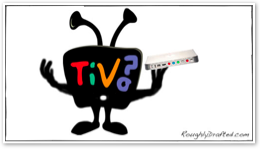



 Send Link
Send Link Reddit
Reddit NewsTrust
NewsTrust






